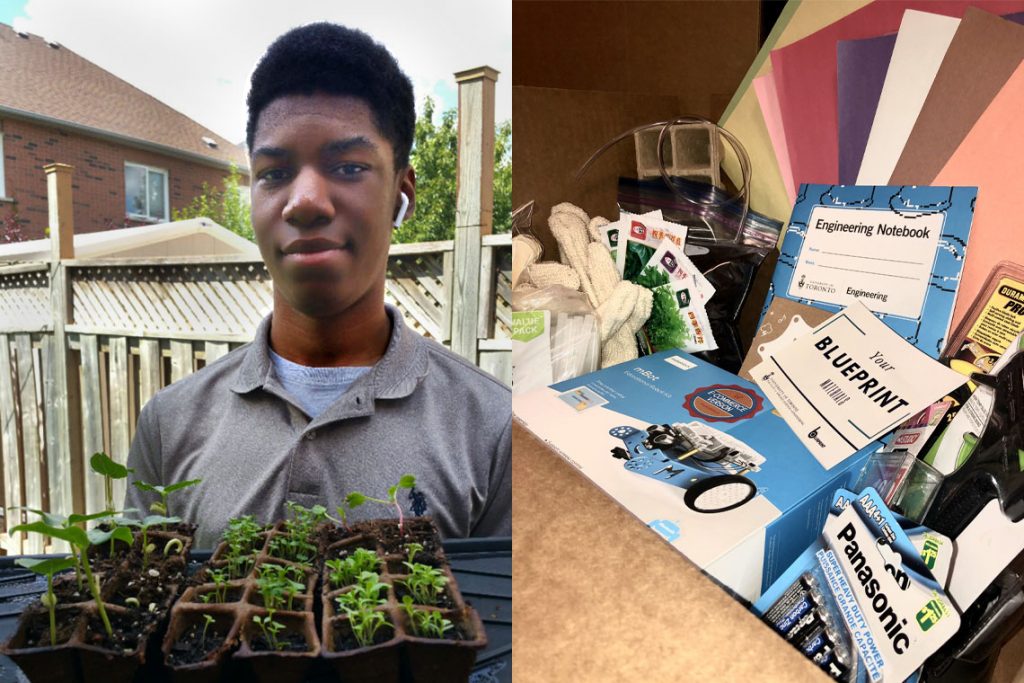Metal Projects for High School Students Mineral Point Clip Art Black and White

Matthew Robinson, a Grade nine student from Brampton, Ont., was ane of 54 Blueprint participants this past summer. Each student received a box of supplies to consummate a range of scientific discipline and engineering activities (photos courtesy of Cassandra Abraham)
A new outreach program at the University of Toronto'due south Kinesthesia of Applied Scientific discipline & Engineering is empowering Black students from across Canada to explore a future in science, technology, engineering and math (Stem).
Launched this summertime, Blueprint engages Black students in Grades 9 to 11 who have a dear of Stalk subjects. It offers them a chance to extend their knowledge of Stem topics and connects them with mentors who can help them sympathize what it is like to study and piece of work in Stem fields on a day-to-day ground.
In its first year, Blueprint attracted more than 50 participants from across Canada.
"I ofttimes hear Black students say that they are the only ones who look like them in their classrooms," saysCassandra Abraham, the kinesthesia's engineering outreach co-ordinator.
Abraham joined U of T Engineering in 2019 with a mandate to enhance programs focused on disinterestedness, diverseness and inclusion, and directed the team that designed and delivered Pattern.
"Equally a Black student who graduated in STEM from a Canadian university, I chronicle to that feeling," says Abraham. "By connecting students with mentors – Black undergraduate students at U of T Engineering science who are besides members of the National Society of Blackness Engineers (NSBE) – that have besides had that experience, nosotros were able to start building a whole new community."
Blueprint builds on other U of T outreach programs, such as ENGage, which aimed at Black students in Grades 3 to 8. Delivered in collaboration with the U of T chapter of NSBE, Appoint has been running for 10 years and aims to spark a lifelong interest in STEM.
Appoint has as well spawned new programs such as Launch: Science and Engineering Camp, which has run in diverse neighbourhoods around Toronto since 2018, and Appoint High Schoolhouse Saturdays, which began this year.
"Later a decade of running programs similar these, we now run across a disquisitional mass of students," saysDawn Britton, associate director, engineering student outreach. "The switch has been flipped. They sense that Stalk is for them and they desire to know more. Blueprint is near giving them the tools they need to take the next steps."
The showtime accomplice of Design participants were identified by teachers, parents or by community members equally being passionate about Stem. While some had previously participated in the outreach programs mentioned above, others were interacting with U of T for the start time, including many who live outside Ontario.
The plan was to bring students to U of T'southward St. George campus for 5 weeks, taking courses and interacting with mentors. But when the COVID-19 pandemic hit, the team quickly pivoted.
"Cancelling never felt like an option," saysLuisa Gragirena-Husbands, a Blueprint team pb. "We were hearing such enthusiasm from the students and their parents that we knew they would desire this to happen, even if it had to be a modified experience."
Over the form of the summer, Blueprint participants completed 3 academic courses online, each of which addressed a critical topic in STEM:
- Foodology & The Hunger for Change
- Equity & Ideals in Bogus Intelligence
- Designing Tomorrow's Sustainable Cities
All courses were taught by a U of T Engineering graduate student who acted as a discipline matter skillful. The courses were designed to provide a gustation of what post-secondary education is like and to expose students to advanced STEM concepts.
The Blackness undergraduate students who served every bit mentors were present online before, during and after each course. This enabled the kind of informal community-edifice interactions that many of the program'southward participants would not otherwise accept had access to.
"As students trickled in there would be music playing and organic conversations almost whatever was happening," says Gragirena-Husbands. "Sometimes it was a pop culture reference or something to exercise with what they learned in form yesterday. After class, they would want to chill and hang out with each other. While we couldn't tour the CN Tower like we had planned, we showed movies and did Tik Tok challenges. We had really high attendance throughout."
The program also included sessions on career exploration, which were guided by students' questions.
"They were super curious about resumes and they wanted to know how to go their kickoff job, so we had a session for that," says Gragirena-Husbands. "Nosotros likewise covered other aspects of professional evolution such as interviewing tips and SMART Goal Setting."
The v weeks of academic programming have now been completed, simply Blueprint is far from over. The students will continue to spend at to the lowest degree six hours per month with their mentors and the squad is hoping to host an in-person conference in March if COVID-nineteen guidelines allow.
For the entire squad, the biggest measures of success were the testimonials received from both the students and their parents.
"Parents told us that their kids would become up early on and were excited to log on because it was the offset time they were in a grade full of people who all look like them, who all had experiences like theirs and who all have the same interests as them," says Gragirena-Husbands. "That in itself is revolutionary."
"Students told us: 'It was amazing to meet brilliant Black engineering students at U of T come together to teach and inspire me, and I want to be like them,'" says Britton. "In my mind, that equals success."
By Tyler Irving
Originally published by Applied science News
Source: https://civmin.utoronto.ca/tag/high-school-students/